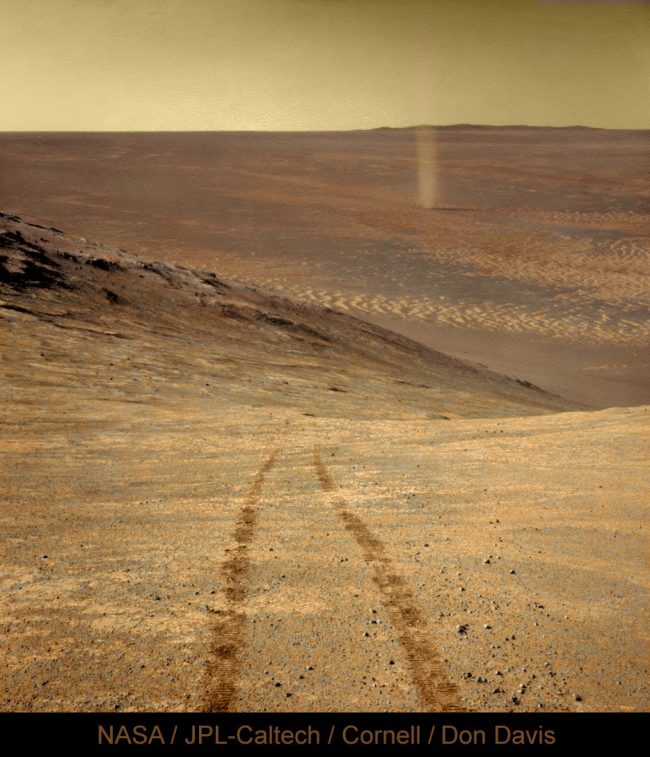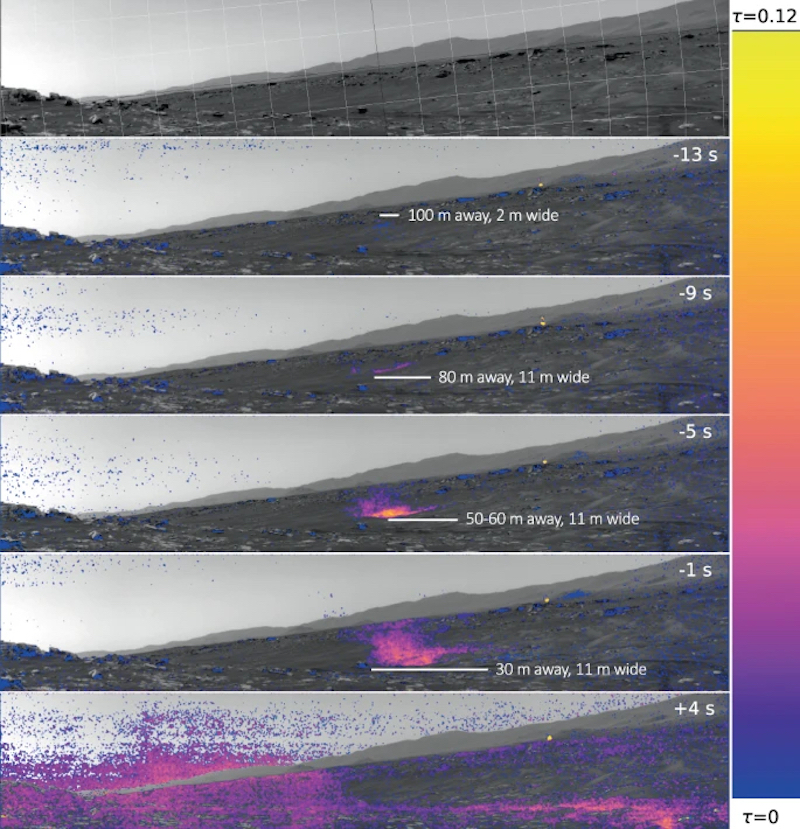
Dust devils are a well-known feature of the desert planet next door, Mars. These tiny tornadoes of dust are a common sight at certain times of year, much as they are on Earth. In fact, as the images on this page show, Mars rovers have all seen and photographed dust devils. But on December 21, 2022, scientists announced that, for the first time, the Mars rover Perseverance has heard a dust devil as it passed over. Perseverance recorded the sounds of swirling, pelting dust and grit. Plus, it took images and other measurements. The rover wasn’t in any danger. In fact, dust devils are the rovers’ friends.
Here’s what a dust devil on Mars sounds like:
An international team of researchers published a peer-reviewed paper related to the newly captured sound of a Mars dust devil in Nature Communications on December 13, 2022. Planetary scientist Naomi Murdoch of NASA and the National Higher French Institute of Aeronautics and Space led the new research.
Recording a dust devil on Mars
Perseverance used its Mast Microphone, part of SuperCam, to record the sounds of the dust devil. At the same time, the SuperCam cameras took time-lapse images. Meanwhile, another instrument on Perseverance – the MEDA environmental station, sent to Mars specifically to measure weather and monitor dust from Mars’ surface – measured a drop in air pressure as the dust devil passed over the rover.
Murdoch said the new research confirms her team’s belief that we need to have both eyes and ears on other planets in order to understand them better. She said:
Our team has been convinced for years of the scientific interest of microphones for a better understanding of the Martian atmosphere. This encounter with the dust devil demonstrates the strong potential of acoustic data in planetary exploration.
Roger Wiens at Purdue University leads the instrument team that first found the dust devil. He said:
We can learn a lot more using sound than we can with some of the other tools. They take readings at regular intervals. The microphone lets us sample, not quite at the speed of sound, but nearly 100,000 times a second. It helps us get a stronger sense of what Mars is like.
Ph.D. student Martin Gillier at ISAE-SUPAERO added:
The soundtrack is extremely rich. We can hear the wind associated with the vortex, but also hundreds of dust grain impacts.

Lucky timing
With sound recordings and images, it’s almost like you’re on Mars seeing the swirling, dancing dust for yourself. As Wiens said:
Just like Earth, there is different weather in different areas on Mars. Using all of our instruments and tools, especially the microphone, helps us get a concrete sense of what it would be like to be on Mars.
The opportunity to record this dust devil was also a bit lucky, since the microphone isn’t on all the time. In fact, it only records for three minutes every couple of days. Even though Perseverance has seen over 100 dust devils since it landed, this is the first time the microphone was on while the whirlwind passed over.

The science of a dust devil on Mars
The sounds, images and other measurements aren’t just interesting for people to hear and see. They also have great scientific value. And even though Mars’ atmosphere is much thinner than Earth’s, dust devils can still put on quite a show, as Wiens noted:
We could watch the pressure drop, listen to the wind, then have a little bit of silence that is the eye of the tiny storm, and then hear the wind again and watch the pressure rise. The wind is fast, about 25 miles per hour [40 kph], but about what you would see in a dust devil on Earth. The difference is that the air pressure on Mars is so much lower that the winds, while just as fast, push with about 1% of the pressure the same speed of wind would have back on Earth. It’s not a powerful wind, but clearly enough to loft particles of grit into the air to make a dust devil.

Dust devils on Mars: The rovers’ friends
The winds in Martian dust devils aren’t strong enough to pose much danger to future human habitats, the researchers also noted. And indeed, dust devils have proven useful to our early efforts to explore Mars. Many times, they’ve blown sand and dust off the solar panels of the Spirit and Opportunity rovers. Wiens said:
Those rover teams would see a slow decline in power over a number of days to weeks, then a jump. That was when wind cleared off the solar panels.
Being able to actually hear what a dust devil on Mars sounds like adds a new dimension to the Perseverance mission. We may not be there in person yet to experience it, but it’s the next best thing.
Bottom line: For the first time ever, a rover has recorded the sound of a dust devil – a mini-tornado of dust and grit – on the desert world Mars. Listen to it here!











